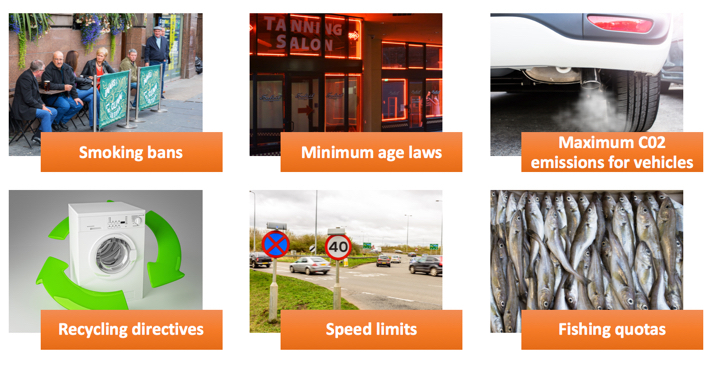We will be going through in class.
Regulation and externalities:
Examples include:
- Laws on minimum age for buying cigarettes and alcohol
- The Competition Act which penalizes businesses found guilty of price fixing cartels
- Statutory national minimum wage
- A new law in Scotland banning under-18s from using sun-beds
- Equal Pay Act and acts preventing other forms of discrimination
- Changes in the law on cannabis
- Maximum CO2 emissions for new vehicles, laws which restrict flight times at night
- Government appointed utility regulators who may impose price controls on privatized monopolists e.g. telecommunications, the water industry (see later)
Regulation and Monopoly
The main aims of competition policy are to promote competition; make markets work better and contribute towards improved efficiency in individual markets and enhanced competitiveness of UK businesses within the European Union (EU) single market.
Competition policy aims to ensure
- Technological innovation which promotes dynamic efficiency in different markets
- Effective price competition between suppliers
- Safeguard and promote the interests of consumers through increased choice and lower price levels
There are four key pillars of competition policy in the UK and in the European Union
- Antitrust & cartels: This involves the elimination of agreements that restrict competition including price-fixing and other abuses by firms who hold a dominant market position (defined as having a market share in excess of forty per cent)
- Market liberalisation: Liberalisation involves introducing competition in previously monopolistic sectors such as energy supply, retail banking, postal services, mobile telecommunications and air transport
- State aid control: Competition policy analyses state aid measures such as airline subsidies to ensure that such measures do not distort the level of competition in the Single Market
- Merger control: This involves the investigation of mergers and take-overs between firms (e.g. a merger between two large groups which would result in their dominating the market)
Main Roles of the Regulators
- Regulators are the rule-enforcers and they are appointed by the government to oversee how a market works and the outcomes that result for producers and consumers
- The main competition regulator in the UK is the Competition and Markets Authority (CMA)
- The European Union Competition Commission is also an important body for the UK (although not for much longer)
Examples of competition policy in action
- De-regulation - laws to reduce monopoly power
- Preventing mergers/acquisitions that create a monopoly
- Laws to introduce competition into the postal services industry
- Forced sales of assets e.g. BAA and airports in the UK
- Privatisation - transferring ownership
- Stock market floatation of the Royal Mail
- Part-privatisation of Network Rail similar to the sell-off of HS1 - the high-speed link that connects London's St Pancras to the Channel tunnel, on a long-term concession
- Tough laws on anti-competitive behaviour
- Strong laws and penalties against proven cases of price fixing or collusion that involves market sharing
- Companies breaching EU and UK competition rules risk hefty fines of up to 10 per cent of global turnover - senior executives can be jailed
- Reductions in import controls
- A reduction in import tariffs encourages cheaper products from overseas
- Increasing or eliminating import quotas can also have the same effect
- Allowing new countries into the European Union single market increases contestability
- Price controls: The government appointed regulators can also impose price capping formula in most of the main utilities such as telecommunications, electricity, gas and rail transport. (this is due to natural monopoly element of these industries)
Regulation may be used to introduce fresh competition into a market – for example breaking up the existing monopoly power of a service provider. A good example of this is the attempt to introduce more competition for British Telecom. This is known as market liberalization.
Free market economists criticize the scale of regulation in the economy arguing that it creates an unnecessary burden of costs for businesses – with a huge amount of "red tape" damaging the competitiveness of businesses.
Problems that regulators of markets / industries can face
- Hard to find evidence of anti-competitive behaviour:
- Lack of spoken or written evidence
- Conflicting or asymmetric information
- Complex information
- Conflicting evidence – e.g. it might be markets forces or collusion in an oligopoly
- Fear of fines or other control mean that there is strong incentive to conceal collusion
- Lack of regulator power and lack of regulator resources

No comments:
Post a Comment